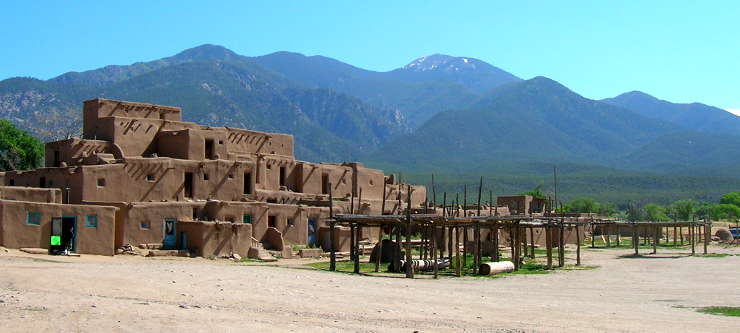Taos Pueblo
- Tuah-Tah: Our Village or At Red Willow Canyon Mouth
- Language: Northern Tiwa
- Size: 99,000 Acres
- Population: 2,200
Taos Pueblo is located about 3 miles north of Taos, about 65 miles north of Santa Fe. The pueblo is located at the foot of the Sangre de Cristo's and a large section of the mountains visible from the pueblo is sacred to the people of the pueblo. The Rio Pueblo, which the Taos people call Red Willow, flows down from Blue Lake and runs between the two houses of the pueblo, providing water for drinking and cooking. The two main structures of the historic pueblo are called Hlaauma (North House) and Hlaukkwima (South House). Rising as high as five stories, these adobe structures are considered among the oldest and largest continuously inhabited structures of North America, right up there in age with Acoma's Sky City and the Hopi's Old Oraibi village. The old pueblo has no electricity or running water and only maybe 50 people still live full time in the structures. Most Taos people live in modern homes outside the old pueblo but still maintain family residences in the village. Many have turned those residences into art galleries and other businesses that cater to the many tourists passing through. Others return to the old village only for sacred ceremonies.
At one time the old village was enclosed in a ten-foot high wall with four large watchtowers. The only entrance to the village was through a large gate. The walls were built for protection against marauding tribes. At the same time, Taos has long been a trading center and many of those marauding tribes came peacefully during gatherings of traders. Today, a much lower adobe wall surrounds the village.
The multi-storied old adobe pueblo was declared a National Historic Landmark in 1965 and designated as a World Heritage Site by the United Nations in 1992.

The North House at Taos Pueblo today
Pueblo History
Pot Creek Pueblo burned and was abandoned in 1275. There was a village of indigenous people at the location of Taos previously and they were joined by some of the refugees from Pot Creek. Those indigenous people had roots extending eastward through the Purgatoire Valley and into the Dismal River Complex area in eastern Colorado, Kansas and Nebraska. The merging of peoples had already begun at Pot Creek and continued at Taos and Picuris. Eventually, the villages settled out as individual pueblos and the semi-nomadic people who occupied the hills and valleys around them became known by the Spanish as Xicarilla.
Whenever Spaniards (and other Europeans) came into their territory, the people of Taos Pueblo opposed them at every turn. However, the Spanish kept coming back and eventually, the Spanish military subdued the pueblo and the Franciscans moved in, building San Geronimo Mission in 1619. Before the Pueblo Revolt of 1680, the leader of the revolt, Popé of San Juan, hid out at Taos Pueblo and met with the pueblo leaders to finalize their plans. Once the revolt began, the warriors of Taos Pueblo destroyed the San Geronimo Mission. Then they had to rebuild it a few years later.
In late 1846, Stephen Wattys Kearny and his Army of the West took New Mexico without firing a shot. They replaced government administrations as they passed through, often granting offices to people who had no rights to such an office. In January, 1847, there was a bloody uprising of Mexican settlers and Taos Pueblo Indians in Taos. They killed several prominent members of the American and Mexican community in Taos, Charles Bent and Cornelio Vigil among them. A couple days later, members of the American community in Santa Fe converged on Taos and extracted bloody revenge on the rebels. When the Americans entered the pueblo, many of the natives had hidden in the San Geronimo Mission Church. The Americans fired a cannon at the mission and blew down the walls. Tragically, all the women, children and old men inside the church perished.
Today, a crumbling bell tower is all that remains of the old chapel. Many of the warriors involved were captured and quite a few were publicly hanged on the Plaza in Taos. There was a similar uprising in Mora at the same time and the Americans put down the rebellion there in just as bloody a manner. They attacked while most of the men were in the forest, hunting. Meeting almost no resistance, the American vigilantes killed all the women and children they found as they burned the settlement to the ground.
The present San Geronimo de Taos Chapel was built in 1850.

San Geronimo de Taos Chapel today
Pottery History
Today, many Taos Pueblo residents make their living in arts and crafts. Taos potters have been making micaceous pottery for hundreds of years, using it for cooking and storage purposes. Micaceous clay pottery is unique in that it can be put directly on the stove and used for cooking. For many years Taos Pueblo was trading pottery vessels, blankets and other goods with the Apache, Comanche and other nomadic tribes on the Great Plains, in return for buffalo meat and hides. Traditional Taos micaceous pottery has no painted decoration but is known for its glittery tan or yellow gold appearance. Sometimes it contains surface embellishments like sculpted appliques of lizards and serpents. In recent years Taos micaceous pottery has taken on new shapes and forms, some even being fired into blackware. Today Taos potters are producing a variety of traditional micaceous pots, miniature seed jars, mudhead figurines and storytellers.
While some Taos Pueblo members are involved in the making of pottery, there are also many jewelers, painters, sculptors and crafters of fine leather products.

Taos Pueblo South House today
Taos Pueblo Potters
- Mike Marcus
- Angie Yazzie